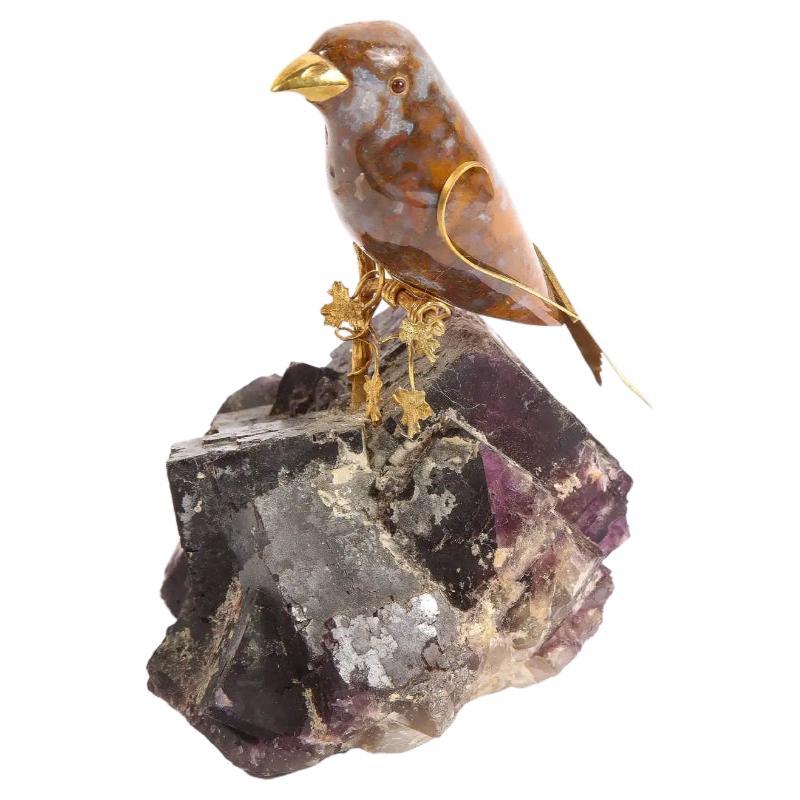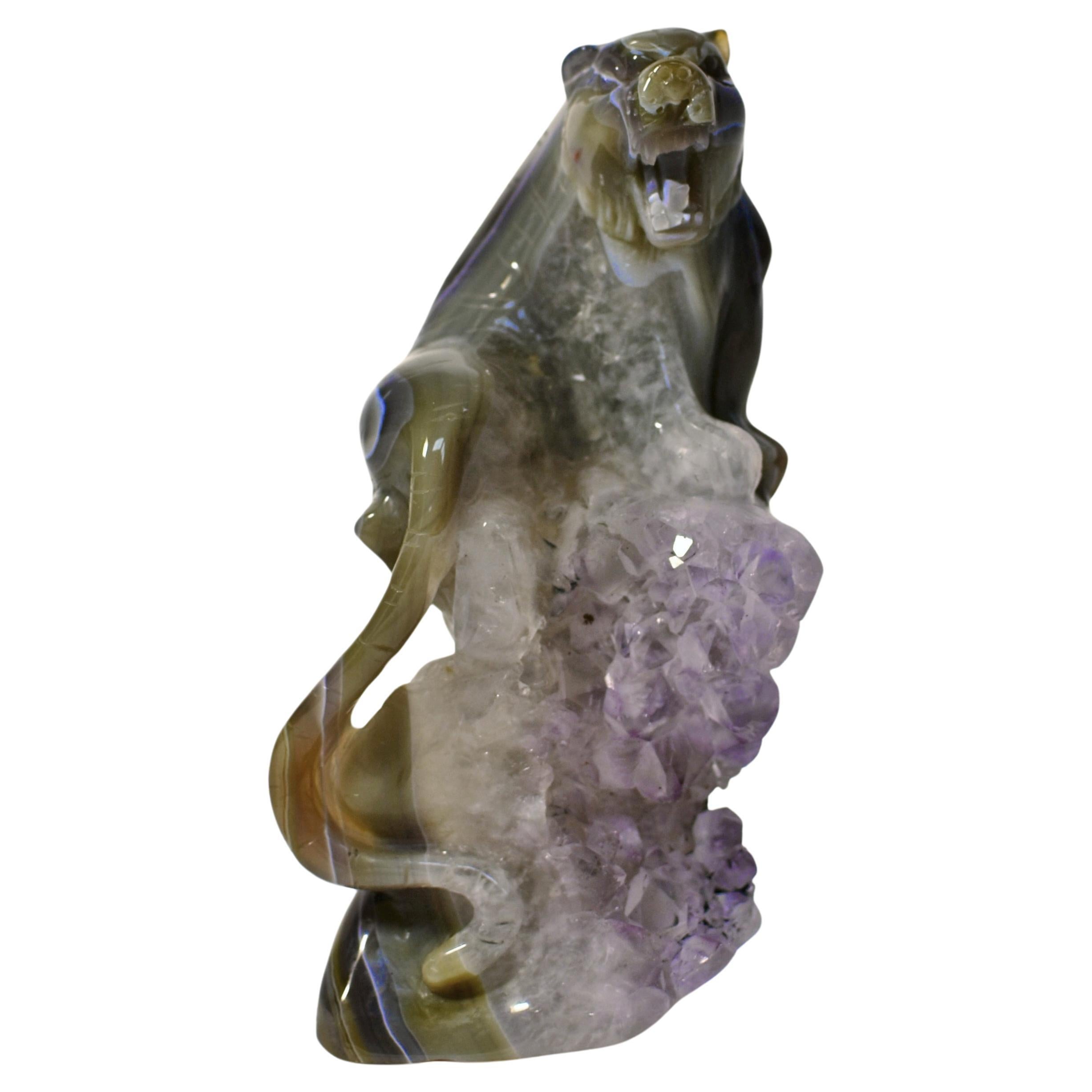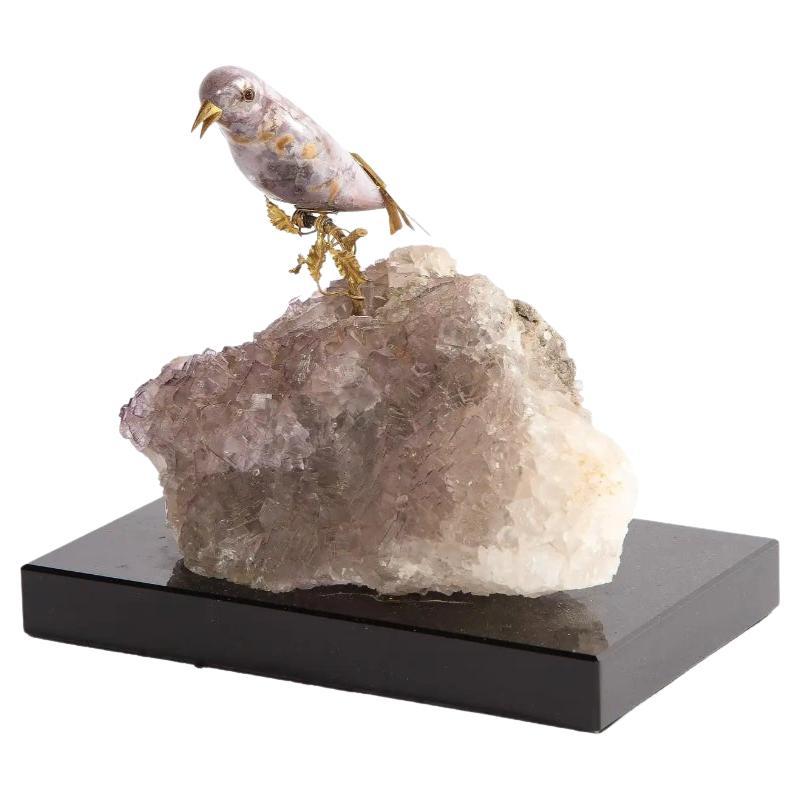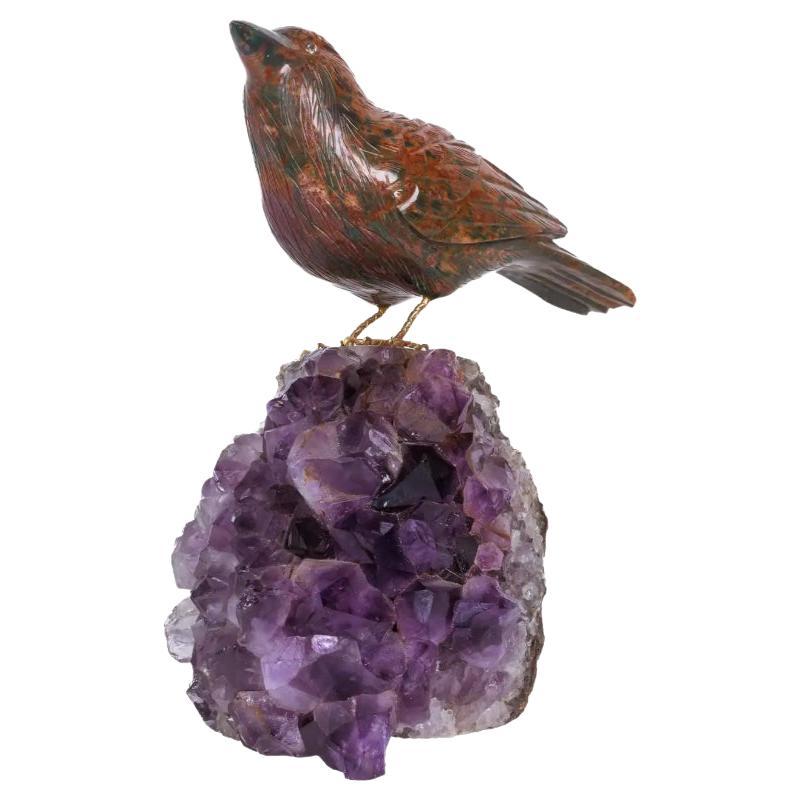Items Similar to Rare Carved Hawk's Eye Agate Tiger on a 14K Gold Mounted Rock Crystal Base
Want more images or videos?
Request additional images or videos from the seller
1 of 14
Rare Carved Hawk's Eye Agate Tiger on a 14K Gold Mounted Rock Crystal Base
About the Item
A rare carved Hawk's Eye agate tiger on a 14k gold mounted rock crystal base, circa 1960.
"A Jeweled Sculpture"
An incredible carved tiger made from hawks eye agate. Realistically carved with perfect-crisp white teeth set with diamond eyes. A perfect object for any jewelry collector.
Measures: 5" high x 7" wide x 5" deep.
Very good condition. No damages noted.
- Similar to:Cartier (Jeweler)
- Dimensions:Height: 5 in (12.7 cm)Width: 7 in (17.78 cm)Depth: 5 in (12.7 cm)
- Materials and Techniques:
- Place of Origin:
- Period:
- Date of Manufacture:circa 1960
- Condition:
- Seller Location:New York, NY
- Reference Number:1stDibs: LU1798229128632
About the Seller
5.0
Vetted Seller
These experienced sellers undergo a comprehensive evaluation by our team of in-house experts.
Established in 1980
1stDibs seller since 2016
58 sales on 1stDibs
Typical response time: <1 hour
- ShippingRetrieving quote...Ships From: New York, NY
- Return PolicyA return for this item may be initiated within 7 days of delivery.
More From This SellerView All
- Rare 18K Gold, Enamel and Diamond Mounted Carved Labradorite Turkey BirdBy Manfred WildLocated in New York, NYA rare 18K gold, enamel and diamond mounted carved labradorite turkey / Capercaillie bird sculpture on a petrified wood base, attributed to Manfred Wild, Idar-Oberstein, Germany. Very finely crafted of the highest quality and best color Madagascar labradorite with excellent labradorescence. The entire hand carved turkey displays and excellent shimmer effect known as labradorescence. Madagascar labradorite, rich in the phenomenal characteristics of this remarkable gemstone which displays an ever-changing sheen, that is extremely suitable for the rendering of this turkey bird...Category
20th Century German Mounted Objects
MaterialsGold, Enamel
- Mellerio Paris, A French Gold, Diamond, Silver-Gilt, Rock-Crystal, & Lapis HorseBy MellerioLocated in New York, NYMellerio Paris, A French Gold, Diamond, Silver-Gilt, Rock-Crystal, Obsidian & Lapis Horse An extremely rare and unique, one of a kind French gold, diamonds, Silver-gilt rock-crystal, obsidian and lapis lazuli jeweled sculpture "Bucéphale, Chevaux de légende", "Bucephalus, A Legendary Horse" by Mellerio, Paris, circa 1998. Sitting on black obsidian base, the solid rock crystal slab is finely applied with a lapis lazuli half-horse with harness mounted in 18k gold and brilliant cut diamonds, between two crystal and lapis lazuli columns adorned with gold and diamonds, insert with 7 ruby cabochons and 1 emerald cabochon, the obsidian base with a plaque engraved: CHEVAUX DE LEGENDE / MELLERIO DITS MELLER / PARIS / 5029 DIV Bucephalus (c355-326 BC) is among the most famous horses in history, and it was said that this he could not be tamed. The young Alexander the Great, of course, tamed him – and went on to ride his beloved equine companion for many years and into many battles. The piece is in excellent condition and comes with a custom made wood case made for transport. It's very elegant and has French hallmarks throughout. A truly magnificent piece. Measures 10" high x 9" wide x 4" deep Founded in France in 1613 by the descendants of Italian immigrants from the Vigezzo Valley in the north of Italy, Mellerio is one of the oldest jewellery houses in Europe. The family business soon attracted the attention of the Royal Court and Marie Antoinette herself reportedly purchased a precious bracelet featuring 7 cameos surrounded by rubies in 1780. Later on, in the 19th century, Mellerio became the official supplier of the French Royal family and the Court of Netherland. Mellerio creates many jewellery items, all set with rare gems such as peridots, amethysts, aquamarines, citrines and topaz, applying for a patent, the flexible stem, a very supple and light jewellery mechanism. Mellerio remains also well known for their spectacular series of Art Nouveau jewels, created at the beginning of the 20th century, as well as for the creation of trophies rewarding some of the greatest footfall and tennis players of history. In 1993, the jewellery house launched their first watch collection. Today, Mellerio has stores in Paris, Japan and Hong Kong. July 14, 1789: this date is known throughout the world as the beginning of the French Revolution. According to a ledger belonging to House of Mellerio, this was also the day that the jeweler sold a golden key to the Comte de Coutance for 10 livres. This ledger, as well as inventories dating as far back as 1768, are the jeweler’s oldest archives. These archives have continued to grow over the years, as the House, established on rue de la Paix in Paris, still lives on today, still in the hands of the same family from Craveggia, in the North of Italy. The tumultuous history of the Mellerio family in France probably goes as far back as the Italian wars of the Renaissance, but the first official document proving their commercial activity in Paris dates back to 1613. This document is the famous royal warrant awarded by Marie de Medici to a number of Italian families established along the rue des Lombards, including the Mellerios, allowing them to sell “small jewelery items”, therefore granting them a small exception to the traditional monopoly enjoyed by Parisian jewelers. At that time, powerful corporations regulated the operations and customs of Parisian business, but thanks to this exceptional warrant, the Mellerios managed to escape the confines of this framework. Today, this wax-sealed document is kept at the city hall of Craveggia. From 1613 to the Revolution, the Mellerios lived between France and Italy. The corporations tried many times to put an end to their trade privileges, but all in vain, as a dynasty of sovereigns renewed the warrant. Always marrying and often retiring in Craveggia, the Mellerios continued to maintain their jewelry business in Paris. At first, they did this without a shop. Wearing backpacks (wooden boxes divided into small compartments where jewels were kept), they would tour town fairs around Paris and royal castles. This is how Jean-Baptiste Mellerio (1765-1850) is said to have sold a bracelet set with rubies and Antique cameos to Marie-Antoinette, which still exists today. Many elements seem to prove the veracity of this anecdote. The queen was particularly fond of cameos, which cover the entire background of her famous jewelry cabinet, and ruby was her favorite stone after diamond. The famous bracelet, reacquired a few years ago by the House of Mellerio, is indeed an 18th century jewel, set with antique cameos representing the profiles of Roman emperors. Two branches of the family were operating in Paris during this time, under the reign of Louis XVI: that of Jean-François (1746-1828), the paternal ancestor of the current Mellerios, and that of Jean-Baptiste (1765-1850). The French Revolution forced them to return to Italy. However, both Jean-Baptiste and François Mellerio (1772-1843), who was the son of Jean-François, were eventually able to return to Paris after the founding of the Consulate. Jean-Baptiste opened a shop at the Iron Crown of rue Vivienne, and François opened his at the Palais des Tuileries, rue du Coq Saint-Honoré. His well-organized order books give an idea of his high-ranking clientele during the “Old Regime”, among which were the Comte and Comtesse Octave de Segur, the Marquise (later Duchess) de Tourzel, former governess of the royal children, and her daughter, the Comtesse de Bearn, the Craufurds -who organized the flight to Varennes, the Duc and Duchess de Gramont, the Comtesse de Boigne, and Madame de Souza, Talleyrand’s mistress. We also see the names of the imperial family: Empress Josephine, the Queen of Holland, Princess Elisa, Caroline and Pauline. At that time, the House of Mellerio specialized, among other things, in the trade of antique cameos, a newly fashionable genre of jewel that captured the imagination of all the princesses and noble women of the time. The years of the Restauration and July Monarchy were among the most glorious. The Bourbons were back on the throne, and the clientele of the House of Mellerio had regained its former wealth. Mellerio supplied Louis-Philippe, Duke of Orléans, as well as his mother, wife and sister, with sumptuous jewels, including a set of emeralds made piece by piece, while the Duke of Bourbon, last prince of the House of Condé, offered diamonds to his mistress, the scheming Baronne de Feucheres, and Monsieur de LaFayette also bought cameos for one of his granddaughters. For the first time, Mellerio ventured into the world of arts in 1815, when Carlotta Grisi, a famous dancer who created Giselle, as well as an actress named Rachel, bought jewels at the Mellerio store on rue de la Paix. 1848 marked a new turning point. France once again became a Republic. François Mellerio handed the company over to his son, Jean, and the latter decided to travel to Spain to build a new clientele. He later became one of the jewelers of the royal family, and met Eugénie de Montijo, who remained a faithful client when she became empress of the French people. The Imperial years were lavish. During the Second Empire, Paris was a pageant of crinoline dresses designed by Worth, while jewels by Mellerio, Worth’s neighbour on the rue de la Paix, adorned the noble women of the Tuileries court. The Empress bought pearls. Mathilde Bonaparte...Category
20th Century French Mounted Objects
MaterialsLapis Lazuli, Rock Crystal, Gold, Silver
- Enamel Gold and Rock Crystal Figure of Emperor Maximilian I by Reinhold VastersLocated in New York, NYA rare enamel, gold and rock crystal figure of Emperor Maximilian I by Reinhold Vasters, Aachen, In the Renaissance style, circa 1870. The g...Category
Antique Late 19th Century German Renaissance Figurative Sculptures
MaterialsRock Crystal, Gold, Enamel
- Exquisite 14K Gold, Diamonds, Emeralds, Rubies, Semi Precious Stone CamelLocated in New York, NYAn Exquisite 14K Gold, Diamonds, Emeralds, Rubies, Sapphires, and Semi Precious Stone Mounted Rhodonite Camel. Possibly by Verdura, circa 1970, Italy. A very good quality and unusual gold mounted jeweled object...Category
20th Century Italian Mounted Objects
MaterialsGold
- An Exquisite and Rare French Louis XVI Style Ormolu-Mounted Bloodstone InkwellLocated in New York, NYAn Exquisite and Rare French Louis XVI Style Ormolu-Mounted Bloodstone Inkwell, circa 1875. A truly exceptional and jewel like quality inkwell encrier, made with the finest ormolu, mounted on bloodstone. A true collectors and one of a kind piece. Revival of the ancient régime in the late 19th century was paramount to the French furniture and bronze casting firms of the Belle Epoque. Imitation in the highest regard and replication of those tastes and styles was prevalent throughout the Paris Faubourg, where the most talented bronziers and ébénistes established their workshops. The present inkwell encrier recalls the late 18th century's obsession with hardstones - a taste expounded above all by the duc d'Aumont and, subsequently Marie-Antoinette. Such hardstone-mounted pieces, reminiscent of Renaissance schatzkammer objects, enjoyed a revived popularity at the end of the 18th century through the impetus of both the marchands-mercier and, more importantly, the hôtel des Menus-Plaisirs, where the duc d'Aumont himself established a workshop in 1770 specializing in the cutting and polishing of precious hardstones. This exceptional inkwell encrier, sumptuously-mounted with finely chased gilt-bronzes, incorporates a highly-prized material such as bloodstone. Sometimes called the Sunstone, the meaning of Bloodstone comes entangled in fascinating history. The Ancient Greeks held the Bloodstone as a gem with glorious powers. They referred to it as Heliotrope, which directly translates to Sunstone. It was believed to have heavenly healing powers gifted by the gods and most certainly when it came to healing all things related to the blood. Even as we move forward into the Middle Ages, the Bloodstone takes another mystical story under its wing. It was believed to be formed from Christ's blood. It was said that during the Crucifixion, a few red spots of his blood dripped...Category
Antique 19th Century French Napoleon III Inkwells
MaterialsBronze, Ormolu
- Isidore-Jules Bonheur, A Rare Gilt and Patinated Bronze Jockey on A HorseBy Isidore Jules BonheurLocated in New York, NYIsidore-Jules Bonheur (French, 1827–1901) A Rare Gilt and Patinated Bronze Jockey on A Horse, circa 1875. Introducing a truly exceptional and highly s...Category
Antique 19th Century French Sporting Art Animal Sculptures
MaterialsBronze
You May Also Like
- 14k Gold Mounted Agate Bird on Carved Amethyst RockLocated in New York, NY14k Gold Mounted Agate bird on carved amethyst rock, 20th Century A really nice and cool object - a true collectors piece. Part of a group of five birds....Category
Antique Late 19th Century Unknown Animal Sculptures
MaterialsAgate, Gold
- Agate Tiger on Amethyst RockLocated in Somis, CAA beautiful Agate tiger on Amethyst rock sculpture, capturing the essence of raw power and untamed majesty. Poised upon a rocky outcrop of splendid purple amethyst, the tiger command...Category
20th Century Chinese Animal Sculptures
MaterialsAgate, Amethyst
- 14k Gold Mounted Agate Bird on Fluorite Stone, Mounted on Black GlassLocated in New York, NYA 14K Gold Mounted Agate Bird on Fluorite Stone, Mounted on Black Glass, 20th century. A really nice and cool object - a true collectors piece. Part of a...Category
Antique Late 19th Century Unknown Animal Sculptures
MaterialsStone, Agate, Gold
- 14K Gold Mounted Agate Bird on Selenium Stone, Mounted on Black GlassLocated in New York, NYA 14K gold mounted agate bird on Fluorite stone, Mounted on black glass, 20th century. A really nice and cool object - a true collectors piece. Measur...Category
Antique Late 19th Century Unknown Animal Sculptures
MaterialsStone, Agate, Gold
- Rock Crystal Tiger Kingdom Sculpture Hand CarvedLocated in Somis, CAA beautiful, hand carved, rare sculpture depicting five tigers in the forest. The sculpture is made of an entire block of natural rock crystal. It is naturally transparent with natur...Category
2010s Sculptures and Carvings
MaterialsRock Crystal, Crystal
- 14K Gold, Carved Jasper Bird on an Amethyst Rock GeodeLocated in New York, NY14K gold, carved jasper bird on an amethyst rock geode Hand-carved jasper bird with diamond eyes and 14k gold feet, sitting on an amethyst geode. A...Category
Antique Late 19th Century Unknown Animal Sculptures
MaterialsAmethyst, Gold





